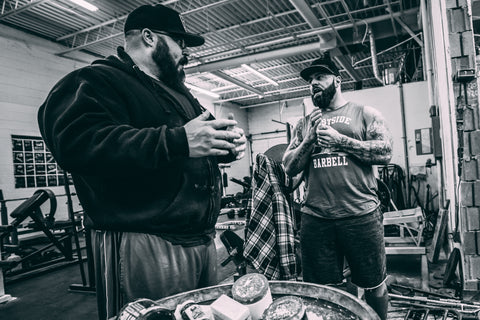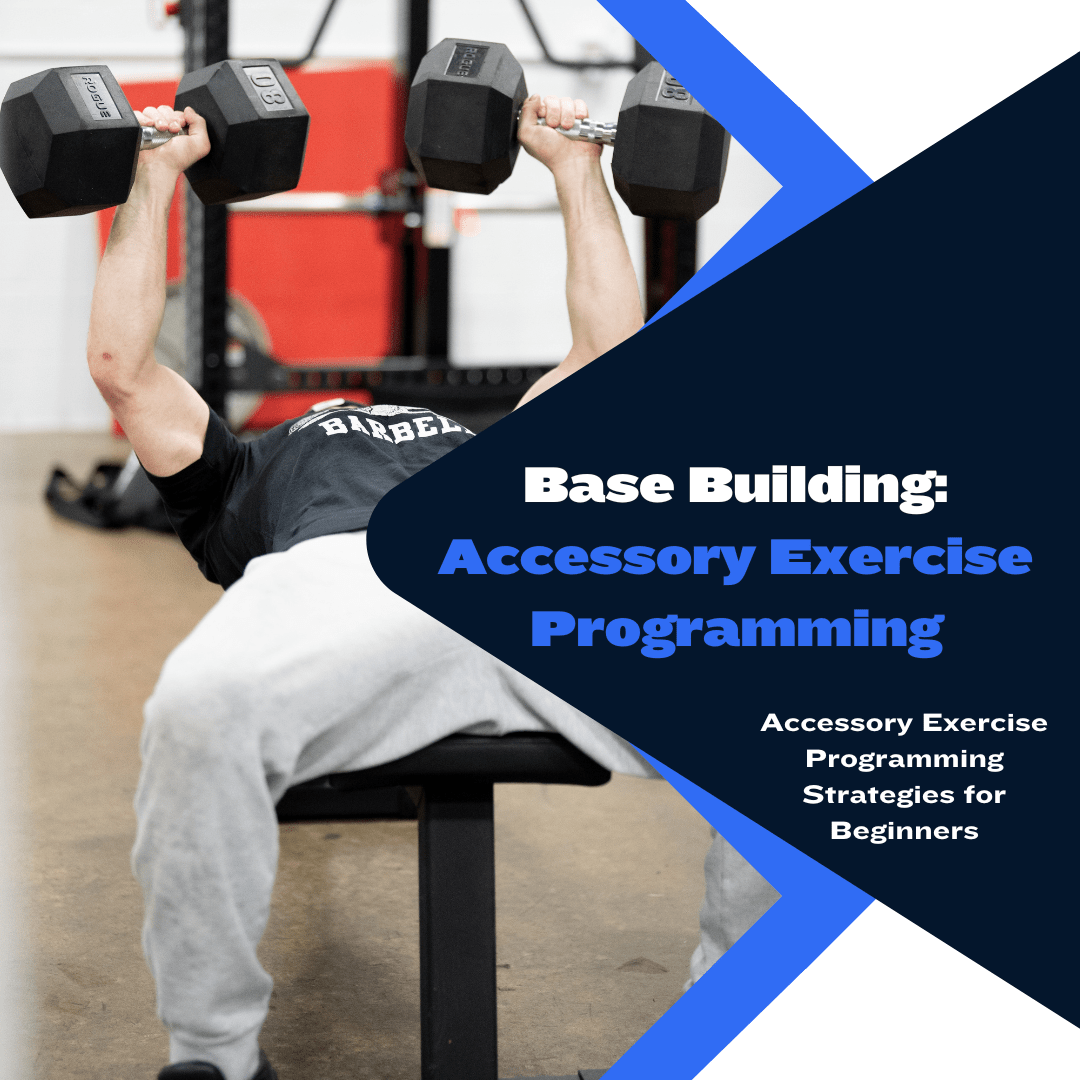Base Building: Accessory Exercise Programming

The Conjugate Method uses three primary training methods: maximal, dynamic, and repeated effort. These methods provide an athlete with comprehensive training, allowing multiple strengths and athletic traits to improve simultaneously. We typically use repeated effort-focused main exercises when working with beginners instead of typical dynamic effort.
Doing this allows an athlete to accrue valuable training volume, typically working at intensity levels between 70-85%. This training helps improve strength and size and eliminates the specific velocity parameters associated with dynamic effort training. With beginners, developing strength and technical proficiency must be prioritized. Using the repeated effort method, we can provide an athlete with ideal training volume at worthwhile training percentages to make meaningful progress in strength and technique.
Aside from repeated effort main exercises, beginners will also use the repeated effort method in the traditional sense - during accessory exercise training. At Westside, we use accessory exercises for a few key reasons. The primary purpose of accessory exercises is to ensure all relevant muscle groups are adequately strengthened to improve strength and technique.
We can also use accessory exercises to address identified weaknesses. However, this is less relevant to a beginner than an experienced athlete. Considering a beginner will have many weaknesses, we are more concerned with applying a balanced approach to our accessory exercise programming. This means ensuring that all involved muscle groups are appropriately trained every week.
Accessory Exercise Strategy for Beginners
Our previous Base-Building articles discussed the value of getting the most adaptation out of the least amount of variation possible. This approach is best because it simplifies tracking progress and places less demand on a beginner to constantly learn a new movement. While variation can be highly beneficial, beginners require much less variation to gain strength.
By using basic accessory exercises, athletes can acclimate to the technical demands of each exercise, allowing them to raise the accessory training intensity a bit each week. Doing so will provide optimal stimulus in the same manner an experienced athlete would with increased levels of exercise variation.
In terms of accessory exercise intensity, beginner athletes should strive to train with challenging weights. However, beginners should never sacrifice their form to train with heavier weights. We want to find a balance between a challenging weight and the ability to maintain proper form when performing each rep and set.
Fatigue will also impact the training weights a beginner can select. Considering beginners will lack work capacity, it is often best to use heavier weights during the first couple of sets and finish the exercise with slightly lighter weights. Doing so helps to eliminate the risk of injury caused by fatigue. While experienced athletes can often escalate the training intensity each set, beginners can quickly fade mid-set and suddenly lose the ability to execute the exercise safely.

Programming Accessory Exercises
No matter the athlete or experience level, appropriately organizing your accessory exercise programming is always necessary. This will ensure that athletes have adequate energy to meet the demands of each exercise without worrying about fatigue negatively affecting technical execution. For instance, if we were planning to perform Romanian deadlifts and calf raises in the same workout, we would want to perform the Romanian deadlifts first, considering it is a more demanding exercise.
The concept behind accessory exercise organization is to perform the most demanding accessory exercises immediately after the main exercise and follow up with less demanding exercises. For beginners, we recommend performing 2-4 accessory exercises after completing the main exercise. Below, we will review proper exercise organization for a beginner-level athlete.
Main Exercise:
Bench Press - work up to a top set of three reps
Accessory Exercises:
Incline Dumbbell Bench Press - 4 x 8-10
Barbell Row - 4 x 8-10
Dumbbell Skull Crusher - 3 x 10-12
Standing Dumbbell Lateral Raise - 3 x 12-15
As you can see, once the main exercise is completed, we immediately follow up with multi-joint movements programmed at moderate intensity. Once these exercises are performed, we move on to slightly lower intensity single-joint movements.
You may wonder how intensity is regulated when no percentage is present. Simple: The rep ranges dictate the level of sustainable training intensity. If we want to up the intensity of an accessory exercise, we will prescribe fewer reps per set. If we want to lower the intensity, we do the opposite. It is not rocket science.
Typically, we recommend limiting each accessory exercise to 3-4 sets when working with beginners.
Avoiding Accommodation
Earlier, we discussed the importance of sticking to basic exercise variations when working with beginner-level athletes. While we want to adhere to this advice, we must also modify our accessory exercise selections regularly to avoid issues with accommodation.
One of the best ways to do this without losing the ability to keep track of progress is to use an "A" and "B" set of accessory exercises each month. You will want two sets of accessory exercise selections for upper and lower training days. You will alternate weekly for a month, then adjust the next month's "A" and "B" exercise selections based on training feedback.
Here is an example of this strategy used for lower body training.
"A" Accessories:
Zercher Squat
Hamstring Curl
Reverse Hyper
Standing Abs
"B" Accessories:
Romanian Deadlift
Leg Press
Kettlebell Swing
GHR Sit-Up
For one month, we will perform our "A" accessory plan on max effort lower training days and follow up with our "B" accessory plan on dynamic effort lower training days. Once the month is complete, we will assign new exercises to each plan depending on training feedback and the athlete's needs. Considering this plan is intended for beginner-level athletes, this approach will provide plenty of exercise variation to ensure positive training adaptations occur without creating steep learning curves as far as technique is concerned.
When we assign new exercises for the next month, we still want to select basic exercises that adequately train all involved muscle groups in the squat, bench press, and deadlift.

Avoid Overcomplicating Accessory Work
Programming for beginner-level athletes should be a simple endeavor. The main goal is to expose the athlete to meaningful levels of volume and intensity while sticking to the basics to develop the muscle groups involved in the competition lifts. We want to choose exercises that are rather simple to execute and provide maximum return on investment in terms of strength gains.
A beginner does not need to perform a movement such as giant cambered bar good mornings with forward-pulling bands. If we want to improve the posterior chain strength of a beginner-level athlete, simple giant cambered bar good mornings or Romanian deadlifts will suffice. It has been said before, but I will mention it again: the goal is to get the most adaptation out of the least amount of exercise variation.
This will help build a base of strength and leave many other movements on the table as the athlete progresses, requiring more specific training inputs to continue progressing. Don't use an excavator for a job that merely requires a shovel. Beginner-level athletes must master the basic movements first, then move on to more complex variations as the need arises.
Sources:
Simmons, L. (2007). Westside Barbell Book of Methods. Westside Barbell.
Verkhoshansky, Y., & Siff, M. C. (2009). Supertraining. Verkhoshansky.
Zatsiorsky, V. M., & Kraemer, W. J. (2006). Science and Practice of Strength Training. Human Kinetics





